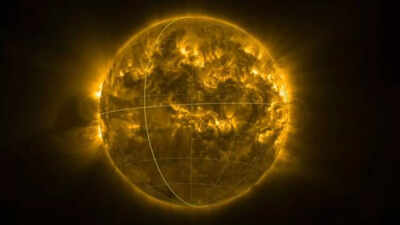ARTICLE AD BOX

On Wednesday, the European Space Agency (ESA) released stunning images that were captured by three instruments aboard the Solar Orbiter. These images are taken from about 40 million miles which is around 65 million kilometers away and these photos provide an unprecedented detailed view of the Sun’s south pole. The Solar Orbiter mission is a joint effort between ESA and NASA.
Historic first images of the Sun’s south Pole revealed
Until now, all observations of the Sun have been made from a single perspective which is directly facing its equator from the same plane in which Earth and most other planets orbit that is known as the ecliptic plane.However, in February, the Solar Orbiter used a gravity assist flyby around Venus to shift its position out of this plane by allowing it to view the Sun from about 17 degrees below the solar equator. Future flybys are planned to increase this angle to over 30 degrees.
On Wednesday, the European Space Agency released images that were captured in March by three instruments aboard the Solar Orbiter. These photos reveal the Sun’s south pole from roughly 40 million miles measuring around 65 million kilometers away, taken during a period of high solar activity. Images of the north pole are still being transmitted.Professor Carole Mundell, ESA’s Director of Science said, “Today we present humanity’s first-ever images of the Sun’s pole. As our closest star, the Sun sustains life but also has the potential to disrupt space and ground-based power systems. Understanding its behavior and learning to predict it is crucial. These new, unparalleled images from the Solar Orbiter mark the dawn of a new chapter in solar research.” According to Prof. Mundell, these are the closest and most detailed images ever taken of the Sun, and they will help researchers better understand how our star functions.

Source: Sky News
Why do these Sun’s south pole images matter?
The Sun is enormous as it measures about 865,000 miles in diameter which is more than 100 times wider than Earth.Hamish Reid, a solar physicist at University College London’s Mullard Space Science Laboratory and the UK co-lead for the Solar Orbiter’s Extreme Ultraviolet Imager explained to Reuters that unlike Earth which has distinct north and south poles, the Solar Orbiter has detected both magnetic polarities currently present at the Sun’s south pole.“The data collected by Solar Orbiter over the coming years will assist scientists in predicting the solar cycle,” he said. “This is crucial for life on Earth because solar activity, including flares and coronal mass ejections, can disrupt radio communications, destabilize power grids, and create spectacular auroras.”During this calmer period, the Sun is less prone to violent eruptions. However, as the magnetic poles flip approximately every 11 years, the fields become more tangled and unstable. This chaotic phase prompts the Sun to restore order, causing solar storms that hurl solar material toward Earth. These storms can disrupt satellites and electrical systems but also produce breathtaking auroras. The Solar Orbiter has captured some images of the Sun’s north pole as well, though the European Space Agency is still awaiting the data to be transmitted back to Earth.
New insights into the Sun’s poles
Professor Carole Mundell, who is the ESA’s Director of Science noted that these are the closest and most detailed images of the Sun that have ever been taken in history. Scientists believe that these images will significantly advance our understanding of the Sun’s processes. The new images will help scientists understand how the Sun transitions between periods of intense solar storms and calmer phases. This knowledge is crucial because strong solar activity can disrupt satellite communications and cause power outages on Earth. The photos reveal a glowing and bright atmosphere with temperatures reaching up to a million degrees Celsius in some areas. Among these are cooler and darker gas clouds that are still scorching at around one hundred thousand degrees.Also read: 10 strange facts about Earth that sound like sci-fi stories



.png)
.png)
.png)
















 23 hours ago
3
23 hours ago
3









 English (US) ·
English (US) ·